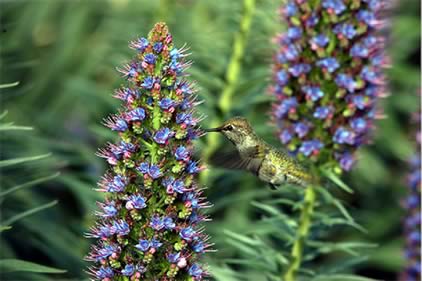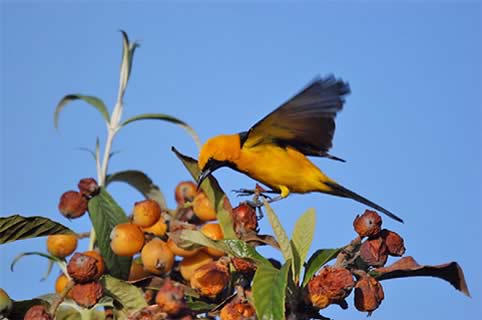|
Getting Ready to Welcome Birds
Walk around the school neighborhood to identify the birds that are common to the area. A bird guide can be useful for identification.
Determine the feeding habits of the birds you wish to attract. Most birds are not specific as to the type of food they eat. Eating habits may vary from summer to winter. Summer insect eaters are likely to eat weed seeds in the winter. Even seed-eaters and hummingbirds catch insects to feed their nestlings.
 |
| Hummingbird |
Photo courtesy of Douglas Aguillard |
Common Birds
Hummingbird
House Finch
House Sparrow
Mourning Dove
Brown Towhee
Mockingbird
Scrub Jay
Robin
Bushtit
Black Phoebe
Hooded Oriole
Lesser Goldfinch |
|
Food Preferences
nectar, insects
weed seeds
insects, weed seeds
seeds
seeds, insects
insects, fruit
nuts, fruit, insects
earthworms, insects, fruit
insects
insects
insects, fruit
seeds |
Protective Cover
Without a doubt, a safe environment is most important for birds’ survival and ultimately for your garden’s success.
Plants for cover can include trees and shrubs of various kinds. Choose varieties that will also provide for secluded nesting, roosting, and food. Fruit trees, shrubs, vines with seeds or berries, and plants that attract insects will determine the species of birds attracted to your garden.
 |
| Hooded Oriole |
Photo courtesy of Douglas Aguillard |
Food
Some suggested plants for fruit, seeds, insects, or nectar include mulberry (not fruitless) and pomegranate trees, berry vines, lantana, pyracantha, sunflower, honeysuckle, and grasses. Click this link http://www.cnpssd.org to go to The California Native Plant Society for lists of natives that attract birds.
Water
A birdbath will be a popular daily gathering place for drinking and bathing. Make sure it is near protective cover for birds, but not where cats may hide and pounce on birds while visiting the bath. Most suitable is a simple, shallow container, 18 to 24 inches in diameter and 2 _ inches deep on a pedestal 2 to 3 feet high. Materials for containers include plastic, ceramic, or concrete, but metal should be avoided as the water could become too hot. The birdbath needs to be kept clean and supplied with fresh water often. More success will be achieved if the water is moving; even a slow drip creating a small ripple will draw birds in. This will also help prevent mosquitoes from breeding in your birdbath.
Feeders
Using feeders is a personal decision for each gardener to make. Keep in mind that bird feeders may attract ‘nuisance birds’ such as starlings and pigeons that are not welcome in the garden. To provide a safe and healthy feeder, be sure to keep it and the area around it clean. Naturalists believe planting hummingbird plants is better for hummingbirds than providing them with sugar water in feeders. Deep throated flowers such as fuchsias, salvias, penstemons, and bottlebush will bring hummers to your garden.
If you do choose to supplement the nectar they obtain from flowers, it is important to take steps to insure their health. Dissolve one part white sugar (sucrose) in four parts warm water. If it is to be kept, this solution should be boiled first and then it may be refrigerated for several weeks if necessary. Using other sweeteners including honey, larger proportions of sugar, or red food coloring could cause harm to birds. The feeders need to be changed about every three days and cleaned before refilling.
The distribution of some species of birds will vary from neighborhood to neighborhood. Birds select their individual territories and may be reluctant to seek or be attracted to other sites. Patience may be required in attracting birds to your garden site.
|

